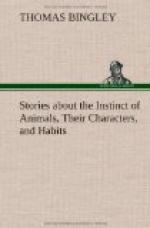“Is the beaver used for food, then, Uncle Thomas?”
“It is, and except during a small part of the year, when it feeds on the root of the water-lily, which communicates a peculiar flavour to the flesh of the animal, it is said to be very palatable. It is, however, principally for its fur that it is hunted; the skin, even, is of little value, being coarser and looser in texture, and of course less applicable to general uses, than that of many other animals. I dare say you have often seen it made into gloves.
“I will now read to you an account of a tame beaver, which its owner, Mr. Broderip, communicated to ’the Gardens and Menagerie of the Zoological Society.’
“The animal arrived in this country in the winter of 1825, very young, being small and woolly, and without the covering of long hair, which marks the adult beaver. It was the sole survivor of five or six which were shipped at the same time, and was in a very pitiable condition. Good treatment soon made it familiar. When called by its name, ‘Binny,’ it generally answered with a little cry, and came to its owner. The hearth rug was its favourite haunt, and thereon it would lie, stretched out, sometimes on its back, and sometimes flat on its belly, but always near its master. The building instinct showed itself immediately after it was let out of its cage, and materials were placed in its way,—and this, before it had been a week in its new quarters. Its strength, even before it was half grown, was great. It would drag along a large sweeping-brush, or a warming-pan, grasping the handle with its teeth, so that the load came over its shoulder, and advancing in an oblique direction, till it arrived at the point where it wished to place it. The long and large materials were always taken first, and two of the longest were generally laid crosswise, with one of the ends of each touching the wall, and the other ends projecting out into the room. The area formed by the crossed brushes and the wall he would fill up with hand-brushes, rush baskets, books, boots, sticks, cloths, dried turf, or any thing portable. As the work grew high, he supported himself on his tail, which propped him up admirably: and he would often, after laying on one of his building materials, sit up over against it, apparently to consider his work, or, as the country people say, ‘judge it.’ This pause was sometimes followed by changing the position of the material ‘judged,’ and sometimes it was left in its place. After he had piled up his materials in one part of the room (for he generally chose the same place), he proceeded to wall up the space between the feet of a chest of drawers, which stood at a little distance from it, high enough on its legs to make the bottom a roof for him; using for this purpose dried turf and sticks, which he laid very even, and filling up the interstices with bits of coal, hay, cloth, or any thing he could pick up. This last place he seemed to appropriate for his dwelling;




